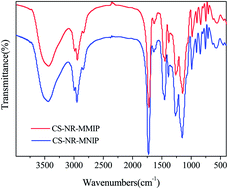Use of core–shell nanoring amino-functionalized superparamagnetic molecularly imprinted polymer for matrix solid phase dispersion extraction and preconcentration of ultratrace levels of BPA from water samples†
Abstract
A new method based on the use of a core–shell nanoring amino-functionalized magnetic molecularly imprinted polymer (CS-NR-MMIP) as an adsorbent for matrix solid phase dispersion extraction (MSPD) has been developed for the highly selective and sensitive determination of ultratrace levels of BPA (Bisphenol A) by ultra-fast liquid chromatography-tandem mass spectrometry (UFLC-MS/MS). The adsorption and desorption conditions including the pH value, shaking time, and sample volume were investigated. The results showed that the adsorption property of the CS-NR-MMIP was highly pH dependent. Under the optimal experimental conditions, the enhancement factor of the CS-NR-MMIP MSPD procedure was 250, the limit of quantitation was 1 ng L−1, the linear range was between 1 ng L−1 and 200 ng L−1 and the correlation coefficient was 0.9992. The results showed that the developed method was faster, easier and more selective for extracting and enriching ultratrace BPA (nanogram per liter level) from water samples than the commercial C18 powder.

- This article is part of the themed collection: Emerging analytical methods for global energy and climate issues

 Please wait while we load your content...
Please wait while we load your content...